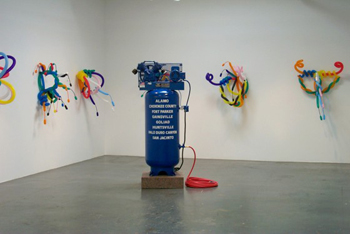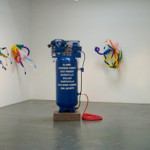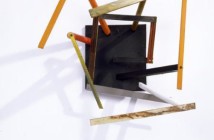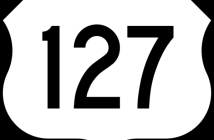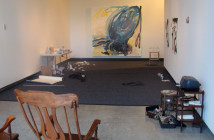Mel Ziegler and Kate Ericson produced some of the most important and challenging work of their generation during their ten-year collaboration between 1985-1995. The largest survey to date of their often overlooked and complex production opened last week at the MIT List Visual Arts Center. Intended, in part, to fill a gap that curators Bill Arning and Ian Berry felt existed between today’s younger artists and the doors Kate Ericson and Mel Ziegler opened for them, “America Starts Here” is an amazing awakening into the complex and profound transactions that can occur when dealing with constituents outside of the artworld.
Labeled today as New Genre Public Art or Site-Specificity, Kate Ericson and Mel Ziegler were some of the first artists to make “the public” or “the community” an integral part of their production. With sincerity, generosity and a smart sense of humor this artistic team managed to transform some basic and simple tasks- mowing a lawn, repairing a sidewalk, replacing tools, building a house- into profound statements on labor, community relationships, power, but perhaps most importantly, the role of the artist in today’s society. I chatted with Mel Ziegler on Friday, February 10th shortly before he delivered an insightful lecture and discussed the methods and strategies they employed during their all too short collaboration.
Micah Malone: One of the striking things about the work is the reciprocal process between the budgets, collectors, the constituents within the groups you engage and the final product of your research. Can you elaborate on the entropy with these money exchanges and other things?
Mel Ziegler: Well it’s not always money, sometimes its just pragmatic things like painting somebody’s house or repairing a sidewalk. The financial things happen to be more in relationship with the art market itself. In that case, it just depended on what the situation was and what we were dealing with in terms of that reciprocity. To us, it was a conceptual thing, a way in which we could engage people on one level, a give and take that went back and forth between us and whoever was letting us do the project. A lot of these people, particularly the house project- we’d never met before. We’d never advertised to try and get people involved, and it was a way in which we could have a relationship: you let us do this and this is what you get in return. This is how it began, but it was also, in a really important way, a deep seated thing in our work that we were interested in. I don’t know if you had a chance to see the video of the public projects?
MM: I did.
MZ: Because in a way, they explain a lot more in terms of what we were trying to accomplish. A lot of times we would throw out ideas because it didn’t do enough of that. You’ll see some projects that aren’t as close to what we wanted. We would literally throw out ideas that didn’t follow that vein of thinking. Loaded Text is probably the best example of how that takes place. Feed and Seed certainly did in terms of the economics, although we weren’t so successful in selling those pieces. Through this show, maybe we will. We sold some, some farmers got as much as 3-4 thousand, so it was quite a bit of financial gain.
MM: The projects always seem to end up with something very practical and useful, like money for the farmers, new tools…
MZ: There’s a certain pragmatic aspect to the work that is really pretty key to the way we thought. And it’s about engaging a form or convention that is familiar to most of us. And in that sense, I think it’s really important that it has that pragmatic aspect. Of course we would never shy away from this idea that we were artists. When we approach people we say, “We’re making art” and that’s what we’re doing. But there’s a language there that people understand if it's about their front lawn, if its about putting landscape down, repairing the sidewalk, whatever. Those are languages that we’re all accustomed to seeing. Its about the urban fabric, it’s the urban fabric that is the form in which these things operate.
MM: You mentioned the Durham project [Loaded Text, 1989] where the sidewalk was repaired, and I’m curious as to how the city was involved, in particular, because it was a revitalization project for Durham and your budget came from the museum, so they are, in a way, funding the city.
MZ: When we went down there, what we were finding was that the city council were doing things to spark the whole project, so they were already trying to do a renovation, or, I don’t know if gentrification is the right word, but they were trying to upgrade the image of downtown. One of the things they were doing already was repairing sidewalks and they were going all over the city and taking sections and repairing them. We noticed it when we’d drive around. It’s just a little thing, a gesture towards something they were trying to accomplish. In that way, that’s why we engaged in that particular form, because it was something that was already being done. The city itself then passed the revitalization- it was a draft. While we were investigating we discovered they had just conducted the city council meeting, we were reading the paper and their it was. They were saying, “We have this plan” and we want public comment. One of the things that they were going to do was to put two copies in the library for public comment. Kate and I thought, well, “how many people are going to go to the library and really read over this thing.” So, part of that process was to make that plan public by doing what we did and relating it to something they were already doing, which was aesthetisizing downtown. We did, in the end, make the plan very public because it got a lot of press coverage, although not always the most pleasing coverage. It turned in to a kind of public art controversy, but that was our fault. We didn’t go into the community and talk about the project first, like we should have. We learned a good lesson.
MM: So the controversy was about not involving the community enough?
MZ: Well, if you think back in those days, it was the time of Jesse Helm and there was a suspicion of artists and public art that was being attacked left and right- anything that had to do with funds from the public. So Durham finally had their controversy. What we expected was that the newspapers would tell the story- just as is. We were pretty clear about the facts and the information, there was nothing we had to hide. All of the money was spent, minus our $2000 fee, back in the city. We hired local contractors, stayed at local hotels, ate at local restaurants, so with a $10000 budget, $8000 of it went back into the community. Though it wasn’t public funds. It was actually private and corporate. So in a way it was a gift to the city. Yet, it got people really upset because they thought that was just way too much money to spend on a section of a sidewalk. But in the end, it is more than just replacing a sidewalk. We were really making a work of art. But its hard to make people understand. The newspaper took the information and just turned it into front page news and that had never happened to us before. It was an awakening as to how to deal with that situation. After that, we just did a lot of footwork- went to communities and let them know what we were doing so that we wouldn’t have a big controversy. It doesn’t mean that people still wouldn’t like the work occasionally, but at least they don’t get angry about it because they know it's coming.
MM: A lack of community involvement was one of the biggest issues with Tilted Arc.
MZ: That just sort of happens, now, these processes, which I’ve also been involved in too, because I sit on the Austin arts commission. Now these projects have really different kinds of processes that people have to deal with- you try to involve the community as much as possible, so its interesting how it has all evolved.
MM: So do you think the public art commissions have really changed in the last ten years, from when most of this work was made?
MZ: Well, yes I think so. In some regard I think they had to be much more conscientious about putting things in a neighborhood or placing things without really having a discussion with who the constituents are. Maybe not all of them, but many have become much more responsible for the placement of public art. You rarely find a plop piece that you found in the late 70s and early 80s. It’s a very different process because most of its designed to integrate with the architect or the landscape architect and its more of a planning process. Rather than after the fact, buying something and placing it there or after the fact having the artist come and do something. They are usually now part of the process.
MM: This period of work, I’m thinking of the artists in the Culture in Action show, are really being looked at today. I’m curious about the subtle poetry you use in dealing with all of the constituents. I’m also interested in how you see some of the artists working today that address labor constituents, someone like Santiago Sierra, but who activate a more brutalist engagement with the community. I’m hoping you could comment on these different approaches and their effects.
MZ: I think right now that this is a really important discussion to have. What is our relationship to these communities? How do we operate within it? And I know there is criticisms levied against even our work in terms of our relationship to the group in Culture in Action. I guess it depends on how one approaches the community and how you build that relationship. In Chicago, so much of it was building trust, they had to trust us and we had to trust them. We spent two years with that group and got to know them really well and just became friends. We’d go and help with fundraisers, help plant gardens and stuff. We weren’t doing it so we could say “look at us now”. We really felt for these people, we really enjoyed them. During the whole process, one of the women’s daughter’s was murdered. I mean, just the kind of things that would happen would form our relationship. I mean it could happen to anyone, but it was just one of those situations that you find yourself in. I think the interesting thing was even when we went to talk to them, it wasn’t like we thought we were going to interview them, they interviewed us. In a way, that was actually a better way of handling it because it was them who had to decide whether or not they liked us. Whether or not we were genuine. It wasn’t like they were saying, “Here we are take whatever you want,”. They made it clear that they had people come in and do things before and were not going to sit back and be used for anything unless they believed in what we were doing. So, that was good. It made us feel better about it. And it wasn’t just a short process, of course we didn’t live there, but I don’t think there is any reason that one has to live there to engage in a community.
We’ve backed away from communities or doing projects that has to do with community because we didn’t have enough time. We did a cap street project where we were being asked to deal with the Mission district. Just going around talking to some of the groups we realized that it was too political, it was beyond us, in terms of what we could do in the period of time that we were given to do something, it was like three months and we said no. It wouldn’t work to do this, we can’t do it, and that was a decision we made because we felt we couldn’t work with the community at that level in that short of a time. It would be superficial for us to do that. It just depends on how you approach it. I know Kate and I were genuine and I know a lot of the artists in Culture in Action were genuine, but then you also have to deal with how the institution is framing the project and that is a whole other issue. As fortunate as I feel to be a part of that whole thing, it was also something that affected all of us in terms of how that was actually portrayed to the world: through press, bus tours, conferences, it that sense it was almost embarrassing. But yet, we were pulled into it, we had to sort of engage it because we wanted our group to feel like they were part of it, yet we didn’t allow them to go out and take a bus tour of this place. We would have if the group would have said “yeah, okay lets do that. Let’s show them what we live like.” But they didn’t want to and it was there decision, not ours.
MM: Do you think this form of engagement with communities as an artform has a lifespan?
MZ: In all forms of production, we always look at them and think how is this working, what does it mean. There are many different ways one can approach that kind of art making. And, many different ways one can approach working with the community. I think Kate and I did it a number of different ways and we would look at the situation and approach it on a level that we thought made the most sense. We worked with groups where we went in with no preconceived idea what it was we were going to do. And in other places we had very specific ideas about what we were going to do. Or, in some cases, we might have parameters like we did with Chicago. We had the paint chart. But we didn't know what it would be. It could have been anything. In order to have direction, we felt in that situation we really needed to have parameters because we only had so much time. We didn't live there. And we knew we were going to go every two weeks to meet with this group. And, it could have taken us two years or more if we didn't have some form of parameters to follow. So we felt it was important that we had those parameters.
But again, through dialogue, through even being in this show, and through some other kinds of things that keep coming up, it's a good time to have a dialogue, what does it mean, I think it's a great thing. I was even thinking about art institutions and how they've become, in some ways, so insular from the rest of the world. And if art institutions in the 21st century are going to become something and not become dinosaurs, I think they're going to have to engage. I think it's inevitable. You know, through the Internet, through media, through all kinds of things and we can't just stay in our studios and make sculpture or paint pictures. I think the notion of working with real issues in the real world will be a necessity. I think we've been there. We've been through that. We've spent the last hundred years sort of dealing with insulating ourselves and now we have to get back to more social issues.
MM: In that sense, it's interesting how seductive your work is just visually. It's made for a museum to preserve, or to keep a kind of reminder about the engagement it had with a community.
MZ: Institutions are slow in transitions. The objects won't go away. The paintings won't go away because…
MM: There's always a spare nail...
MZ: Yes, it's like what John Baldessari said in the early 80's when everyone said painting was dead, painting wasn’t dead. Of course it wasn't dead. Here you had Julian Schnabel and David Salle. Basically his response was well, you know, a hammer's a good tool. It's been around forever and probably that's the same with painting. So, I don't know. It's not like I'm looking at that type of thing disappearing. I think what we discovered, we had been working and doing these projects that were public projects and no one really seemed to know about them. I mean, they were interested, but they weren't really looking at it, and we suddenly had a show in a gallery, a commercial gallery, and suddenly everyone's interested in the other work, too. So, I think that we knew that the language, this kind of context of the art gallery and museums, was not necessarily a bad thing, it's where the dialogue happens. But how do you engage it and still do the other work. So, I don't think we were against one or the other, I think in order to make that work interesting both of those things had to exist. They have some relationship to doing something outside – whether it was collecting wood from someone building a house or taking windows out of an abandoned building or whatever. There was always this relationship to something outside. That was what we always attempted to do, even with our museum projects, to have this dialogue that was beyond the walls, the context of the institution, even the gallery shows came from outside. In a way, that kind of relationship was pretty important. We were not anti-gallery; we were not anti- museum.
MM: Perhaps the most subtle piece in the show is the white walls [MoMA Whites, 1990]. Its almost invisible in a way.
MZ: Well I think that is because we are dealing with something that also seems very subtle to begin with. And so, in a sense, it reveals exactly what it is talking about. A slight personal preference, but something like a white, which could be a soft white or a cool white could become the basis for someone’s exhibition, whether it be a curator from the Museum of Modern Art, which is this quintessential institution of preserving and re-presenting art. So in terms of the personal aspect and how important that seems when so much of that is also about being objective. But here’s this subtle thing, like the color of white, that does affect how you see things.
MM: The white cube is supposed to be so objective and this subtle intervention shows how much design really is in place. Was this project connected to the placement of the first names on objects?
MZ: It was called Signature Piece. And our research at that point produced a number of different projects. We do the projects and then we do these other objects and come out with some new research and in that case, yes. We did Leaf Peeping which is also in the show. There was a piece called Fallen MoMA which is kind of like Leaf Peeping but its just 5 jars of paint with different colors. Now the thing about MoMA Whites was that we didn’t get that formula until 1990 because one of the workers who worked there didn’t want to tell us because he was afraid he would get fired. So he kept it secret until he left MoMA and then he allowed us to have the formula. That is why that one is dated a little later.
MM: What projects are you working on now?
MZ: Well, if your interested you can go online. The last two projects had to do with collecting air. So in some ways it continues the vein of the other work but it really has become my own. I went through a series of different trials and errors of things and kind of had to re-establish myself as a working artist and individual. One project I worked on is called Hold your breath and I collected air. I'm living in Texas now so I collected air from historic sites around Texas, they have all that mythology which is something that really ties into an American view of Texas mystique or mythology, and also it's relationship to landscape. So I literally went with a compressor and sucked the air out of places like the Alamo and Goliad and San Jacinto. So if you were from Texas these are things that you would know. These are things that are a part of your history. The only place that was more contemporary was Huntsville which is where the death chamber is, that's when Bush was Governor and there were like 220 people that were put to death in one year, which was a phenomenon. It just freaked me out so much to think about that I thought I had to get air. That was a real contemporary one. I didn't use Waco but most of them were pretty much from the past. I placed it in this 60-gallon tank which stands pretty tall, about 6 or 7 feet, and has a compressor on top. I had this sign painter write the names of the places Alamo, Goliad, San Jacinto…And then I hired a balloon artist who did these great balloons. Hats. They were all hats, they were very elaborate. Each hat had about 20 different balloons with colors and I used the air from the compressor to fill the balloons. And around the gallery which was quite long, about 60 feet, I placed about 35 of these big hats, and the compressor sat in the gallery. But as the exhibition went on, the air seeps out of the latex and by the end of the exhibition, they're just shriveled up. So that was one project that I did recently. I was pleased that I felt like I finally sort of found a place, a voice.
 Read Christian Holland's review
Read Christian Holland's review
"Kate Ericson & Mel Ziegler @ MIT List"
in this issue.
Links:
Mel Ziegler
MIT List Visual Arts Center
"America Starts Here: Kate Ericson and Mel Ziegler" is on view from February 9-April 9, 2006 at the MIT List Visual Arts Center
All images are courtesy of the artists and MIT List Visual Arts Center.

